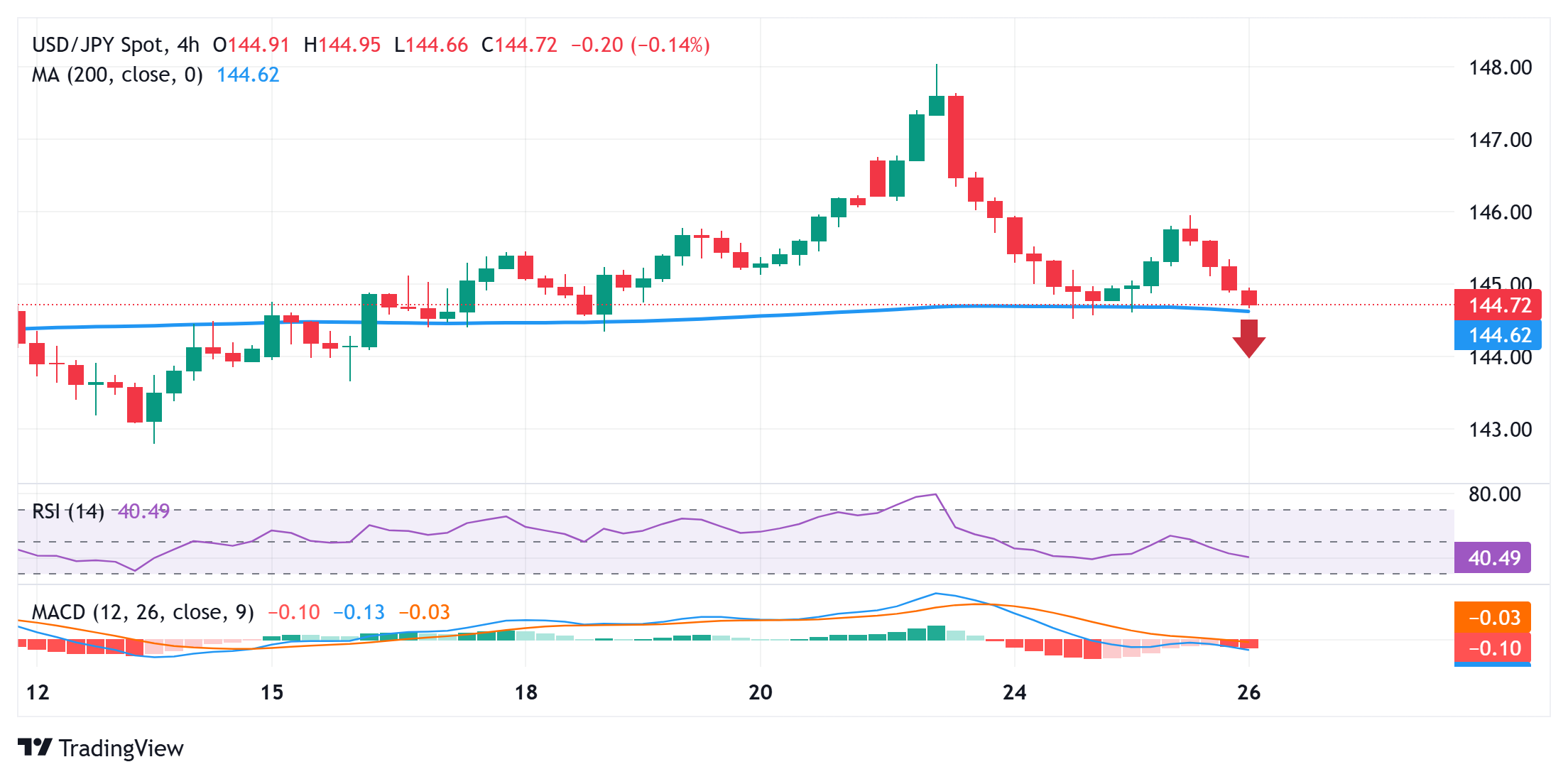
- The Japanese Yen attracts fresh buyers following the previous day’s modest decline.
- The USD slumps to over a three-year low and exerts additional pressure on USD/JPY.
- Traders now look forward to key inflation figures from Japan and the US on Friday.
The Japanese Yen (JPY) intraday buying remains unabated through the early European session on Thursday, which, along with a broadly weaker US Dollar (USD), drags the USD/JPY pair to a nearly two-week low in the last hour. The growing acceptance that the Bank of Japan (BoJ) will hike interest rates further amid signs of broadening inflation in Japan turns out to be a key factor that continues to underpin the JPY.
Meanwhile, reports that US President Donald Trump was considering replacing Federal Reserve (Fed) Chair Jerome Powell fuels concerns over the future independence of the central bank and further underpins the JPY’s safe-haven status. Moreover, the Trump-Powell standoff and Fed rate cut bets drag the USD to over a three-year low, which is seen as another factor exerting downward pressure on the USD/JPY pair.
Japanese Yen strengthens as Trump’s criticism of Powell boosts safe-haven demand
- The Bank of Japan signaled a cautious approach to unwinding its long-standing ultra-loose policy and decided to slow the pace of reduction in its bond purchases from fiscal 2026. However, the incoming data from Japan points to a consistent rise in inflationary pressures and keeps hopes alive for more rate hikes by the BoJ.
- In fact, Japan’s core inflation has remained well above the BoJ’s 2% target for well over three years and rose to a more than two-year high in May. Moreover, Japan’s Corporate Services Producer Price Index – a leading indicator of consumer price inflation – has been trending above the 3% YoY rate for several consecutive months.
- Meanwhile, Federal Reserve Chair Jerome Powell, testifying before Congress, acknowledged that recent inflation readings had been more moderate, but he warned that new tariffs could change that. Powell added that he expects policymakers to stay on hold until they have a better handle on the impact of tariffs on consumer prices.
- Powell’s position on interest rates is increasingly at odds with US President Donald Trump, who ramped up his criticism of the central bank chief and floated the idea of firing him. When asked if he is interviewing candidates to replace Powell, Trump said he has three or four people in mind as contenders for the top Fed job.
- Nevertheless, traders are still betting that the Fed will lower rates by at least 50 basis points before the end of the year and are also pricing in a roughly 20% chance of a rate reduction in July. This, in turn, drags the US Dollar to over a three-year low and the USD/JPY pair closer to the weekly trough during the Asian session.
- A ceasefire between Israel and Iran appears to be holding for now, which might continue to underpin the global risk sentiment and cap traditional safe-haven assets, including the Japanese Yen. Traders now look to the release of the final Q1 GDP, though the focus will be on key inflation figures from Japan and the US on Friday.
USD/JPY seems vulnerable; break below 200-SMA pivotal support on H4 in play

The overnight failure ahead of the 146.00 mark and a subsequent break below the 200-period Simple Moving Average (SMA) on the 4-hour chart, currently around the 144.70-144.65 region, will be seen as a key trigger for the USD/JPY bears. Given that oscillators on hourly/daily charts have just started gaining negative traction, spot prices might then accelerate the fall towards the 144.00 round figure en route to the 143.70-143.65 region before eventually dropping to test sub-143.00 levels.
On the flip side, any attempted recovery back above the 145.00 psychological mark is more likely to attract fresh sellers near the 145.25-145.35 static barrier and remain capped near the 146.00 mark. The latter should act as a pivotal point, which if cleared could shift the near-term bias in favor of bulls and lift the USD/JPY pair to the 146.65-146.70 region en route to the 147.00 round figure. The momentum could extend further towards the 147.45-147.50 hurdle before the pair makes a fresh attempt to conquer the 148.00 mark.
US Dollar PRICE Today
The table below shows the percentage change of US Dollar (USD) against listed major currencies today. US Dollar was the strongest against the Canadian Dollar.
| USD | EUR | GBP | JPY | CAD | AUD | NZD | CHF | |
|---|---|---|---|---|---|---|---|---|
| USD | -0.37% | -0.56% | -0.71% | -0.17% | -0.42% | -0.30% | -0.42% | |
| EUR | 0.37% | -0.12% | -0.37% | 0.23% | -0.01% | 0.09% | -0.02% | |
| GBP | 0.56% | 0.12% | -0.24% | 0.36% | 0.12% | 0.23% | 0.10% | |
| JPY | 0.71% | 0.37% | 0.24% | 0.57% | 0.34% | 0.41% | 0.32% | |
| CAD | 0.17% | -0.23% | -0.36% | -0.57% | -0.23% | -0.22% | -0.25% | |
| AUD | 0.42% | 0.00% | -0.12% | -0.34% | 0.23% | 0.02% | -0.01% | |
| NZD | 0.30% | -0.09% | -0.23% | -0.41% | 0.22% | -0.02% | -0.03% | |
| CHF | 0.42% | 0.02% | -0.10% | -0.32% | 0.25% | 0.01% | 0.03% |
The heat map shows percentage changes of major currencies against each other. The base currency is picked from the left column, while the quote currency is picked from the top row. For example, if you pick the US Dollar from the left column and move along the horizontal line to the Japanese Yen, the percentage change displayed in the box will represent USD (base)/JPY (quote).
Information on these pages contains forward-looking statements that involve risks and uncertainties. Markets and instruments profiled on this page are for informational purposes only and should not in any way come across as a recommendation to buy or sell in these assets. You should do your own thorough research before making any investment decisions. FXStreet does not in any way guarantee that this information is free from mistakes, errors, or material misstatements. It also does not guarantee that this information is of a timely nature. Investing in Open Markets involves a great deal of risk, including the loss of all or a portion of your investment, as well as emotional distress. All risks, losses and costs associated with investing, including total loss of principal, are your responsibility. The views and opinions expressed in this article are those of the authors and do not necessarily reflect the official policy or position of FXStreet nor its advertisers. The author will not be held responsible for information that is found at the end of links posted on this page.
If not otherwise explicitly mentioned in the body of the article, at the time of writing, the author has no position in any stock mentioned in this article and no business relationship with any company mentioned. The author has not received compensation for writing this article, other than from FXStreet.
FXStreet and the author do not provide personalized recommendations. The author makes no representations as to the accuracy, completeness, or suitability of this information. FXStreet and the author will not be liable for any errors, omissions or any losses, injuries or damages arising from this information and its display or use. Errors and omissions excepted.
The author and FXStreet are not registered investment advisors and nothing in this article is intended to be investment advice.








